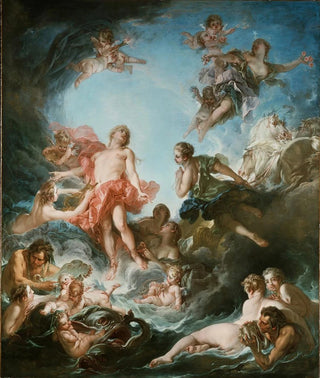Art print | Sunrise - François Boucher


View from behind

Frame (optional)
Art print The Sunrise - François Boucher – Captivating Introduction
In the rich and fascinating universe of art, some works manage to capture the very essence of beauty and light. "The Sunrise" by François Boucher is one of those creations that evokes an atmosphere of serenity and freshness, like a gentle whisper at dawn. This painting, emblematic of the Rococo style, invites the viewer to immerse themselves in a world where nature and art intertwine harmoniously. The scene depicts a fleeting moment, when the morning light delicately caresses shapes and colors, revealing the magic of a new day. Through this piece, Boucher transports us into a dreamlike universe, where every brushstroke seems to breathe life.
Style and uniqueness of the work
Boucher's work stands out for its bold use of color and light. "The Sunrise" is characterized by delicate pastel shades that evoke the softness of a peaceful morning. The hues of pink, blue, and gold blend to create an ethereal, almost celestial atmosphere. The Rococo style, of which Boucher is one of the leading representatives, manifests here through a light and dynamic composition, where shapes are rounded and lines are fluid. The depiction of nature is both realistic and idealized, offering a romantic vision of the world. The characters, often portrayed in graceful poses, seem to dance to the rhythm of the light, bearing witness to the harmony between man and his environment. This work invites silent contemplation, where each detail reveals a new facet of beauty.
The artist and his influence
François Boucher, born in 1703, is an emblematic figure of 18th-century French art. His work is marked by a deep attachment to mythology, nature, and daily life, which gives him an unparalleled singularity. Boucher was able to capture the spirit of his time, blending sensuality and delicacy, while drawing inspiration from Italian masters. His influence is felt not only in his own creations but also among many artists who succeeded him. As a court painter, he

Matte finish

View from behind

Frame (optional)
Art print The Sunrise - François Boucher – Captivating Introduction
In the rich and fascinating universe of art, some works manage to capture the very essence of beauty and light. "The Sunrise" by François Boucher is one of those creations that evokes an atmosphere of serenity and freshness, like a gentle whisper at dawn. This painting, emblematic of the Rococo style, invites the viewer to immerse themselves in a world where nature and art intertwine harmoniously. The scene depicts a fleeting moment, when the morning light delicately caresses shapes and colors, revealing the magic of a new day. Through this piece, Boucher transports us into a dreamlike universe, where every brushstroke seems to breathe life.
Style and uniqueness of the work
Boucher's work stands out for its bold use of color and light. "The Sunrise" is characterized by delicate pastel shades that evoke the softness of a peaceful morning. The hues of pink, blue, and gold blend to create an ethereal, almost celestial atmosphere. The Rococo style, of which Boucher is one of the leading representatives, manifests here through a light and dynamic composition, where shapes are rounded and lines are fluid. The depiction of nature is both realistic and idealized, offering a romantic vision of the world. The characters, often portrayed in graceful poses, seem to dance to the rhythm of the light, bearing witness to the harmony between man and his environment. This work invites silent contemplation, where each detail reveals a new facet of beauty.
The artist and his influence
François Boucher, born in 1703, is an emblematic figure of 18th-century French art. His work is marked by a deep attachment to mythology, nature, and daily life, which gives him an unparalleled singularity. Boucher was able to capture the spirit of his time, blending sensuality and delicacy, while drawing inspiration from Italian masters. His influence is felt not only in his own creations but also among many artists who succeeded him. As a court painter, he






